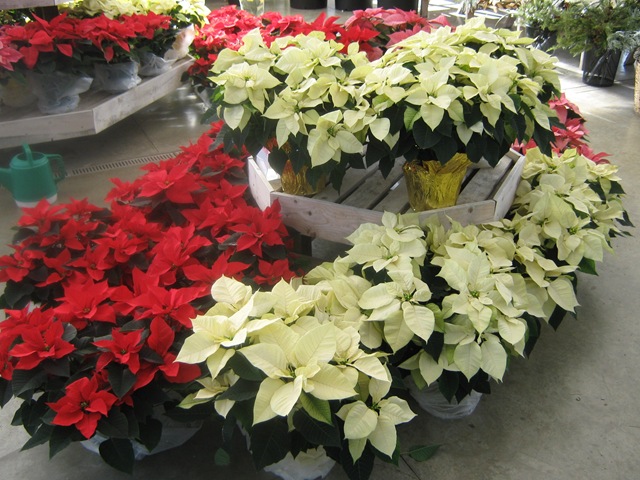The Annual Christmas Beauty
By Jos Van Hage

Over the next few weeks there will be many flowering plants sold as gifts or for decoration. Of all the flowering plants the poinsettia is the most popular as no plant says Christmas more than a red poinsettia. Although they come in many different shades or red, pink, white, speckled, bi-coloured, etc red is still the favourite colour. Poinsettias can look good throughout the season and well into January if given the proper care.
You always want to choose a healthy poinsettia that has fresh looking foliage that has no yellowing or wilting. Foliage should run down the length of strong sturdy stems. Avoid buying plants that are displayed near cold, windy locations or hot dry areas and they should not be wrapped until they are ready to be brought outdoors. If a poinsettia is left in its wrapper for more than a day the leaves will begin fall off because of the ethylene gas the leaves produce.
For long lasting blooms check the cluster of little yellow buds (cyathias) found in the centre of the coloured bracts as these are the true flower. The yellow buds should be tight and unopened with no signs of yellow pollen at the time of purchase. The coloured bracts that surround the true flower are coloured leaves and are there to attract pollinating insects to the true flower.
Poinsettias are very sensitive to cold temperatures and should always be wrapped before transporting them. It should be the last stop before going to your destination as you don't want them to sit in a cold vehicle as this could harm them.
Finding a suitable location for a poinsettia will help prolong their bloom time. Choose a well lit location where it will receive 6-8 daily hours of natural daylight. For even growth, turn the plant every few days so that all sides will receive even light. Keep it away from cold drafts that come from outside doors or cold window sills. Also keep it away from heating vents, fireplaces and other sources of dry air. They enjoy temperatures of 18-22 Celsius and can go slightly cooler at night.
Moisture is very important in a poinsettias good health. Do not let it dry out as this will cause the leaves to drop but do not keep it too wet as this will also cause the leaves to drop. The plant should be kept evenly moist so when the top of the soil feels dry give the plant a thorough watering using room temperature water. Drain off any excess water after 20-30 minutes so that the plant is not sitting in water for any length of time.
By properly caring for a poinsettia it can remain looking healthy and beautiful for many weeks. By March/April the coloured bracts will loose their colour and then you can either put the plant in the compost or keep it for the following season.
To keep the plant for next season, give it a rest by cutting it back by half and then cut down on the water and place it in a cooler area of the home. By the end of May when there is no more threat of frost the plant can be planted outdoors in an east or west location for the duration of the summer and be brought indoors before the first fall frost.
Plant into a pot using a good quality indoor potting soil. Give the plant a good trim so that it looks full and place it in a well lit location. Continue to care for it, watering when the soil feels dry and by the beginning of October the plant is ready to be put back into bloom.
Because poinsettias are a short day plant the shortened days in nature will cause the plant to re-bloom so this needs to be done in the home. Place the plant in an area where it will receive 14 hours of uninterrupted darkness and 10 hours of light every day. It needs to be complete darkness for this process to work and placing a black garbage bag over the plant for 14 hours every night will also work. By November the bracts will colour and the plant is ready for an other holiday season!
-Jos
Jos Van Hage owns and operates two Art Knapp Home and Garden Centres in Prince George:
· Highway 97 north at Northwood Pulpmill Road
· Highway 16 West at Kimball Road
Previous Story - Next Story
Return to Home








